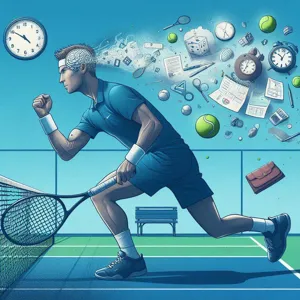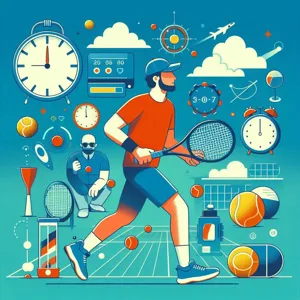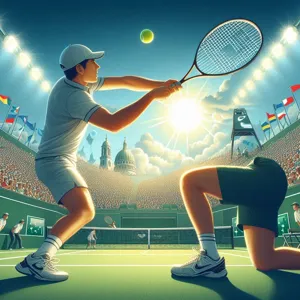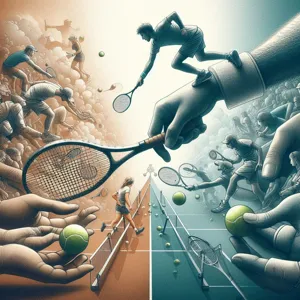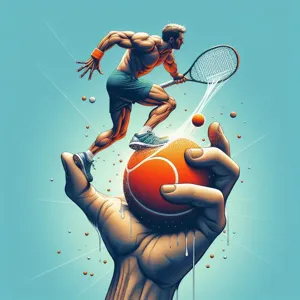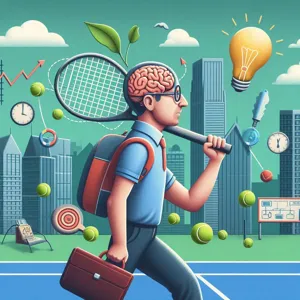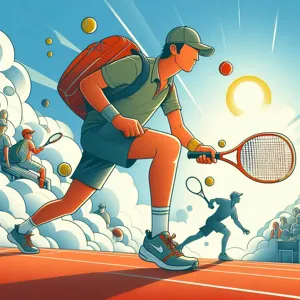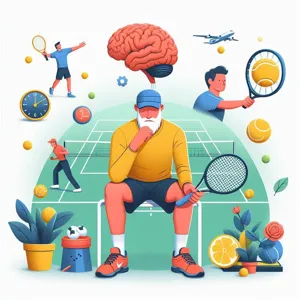Tennis is not just a game; it’s a dynamic fusion of agility, strategy, and endurance that can elevate your fitness levels while you enjoy the thrill of competition.
Whether you’re a seasoned pro or a weekend warrior, incorporating fitness into your tennis routine can enhance your performance on the court and contribute to your overall health. However, balancing the demands of the sport with a comprehensive fitness regimen can often be a challenge. In this blog post, we’ll explore top tips to help you stay fit while playing tennis, from tailored warm-up routines and strength training exercises to nutrition strategies that support your energy levels. Get ready to serve your fitness game and discover how to maximize your time on the court while ensuring you remain in peak physical condition!
1. Introduction: The Connection Between Tennis and Fitness

Tennis is more than just a game; it’s a dynamic fusion of strategy, skill, and stamina that serves as a fantastic avenue for staying fit. As you step onto the court, you’re not just preparing for a match; you’re engaging in a full-body workout that challenges your cardiovascular endurance, strengthens your muscles, and sharpens your mental acuity. The fast-paced nature of tennis demands quick footwork, powerful serves, and strategic shot placement, all of which combine to elevate your heart rate and promote overall fitness.
The beauty of tennis lies in its versatility—it caters to players of all ages and skill levels, making it an accessible option for those looking to improve their physical health. Whether you’re a seasoned player competing in local tournaments or a beginner hitting the courts for fun, the benefits of playing tennis extend beyond improving your game. regular practice enhances agility, coordination, and flexibility while also providing a social outlet that can motivate you to stay active.
Moreover, the sport’s inherent variety keeps workouts engaging and enjoyable. Each match is different, presenting unique challenges that push players to adapt and evolve. This constant movement and mental engagement not only burn calories but also release endorphins, leading to an uplifted mood and reduced stress levels. In essence, playing tennis offers a holistic approach to fitness, blending physical exertion with mental stimulation and social interaction.
As we delve deeper into this blog post, we will explore essential tips to help you harness the fitness benefits of tennis while ensuring you stay in peak condition both on and off the court. Get ready to serve your fitness goals while enjoying every powerful swing and strategic play!
2. Importance of a Proper Warm-Up Routine
When it comes to tennis, the importance of a proper warm-up routine cannot be overstated. Engaging in a thorough warm-up is essential for preparing both your body and mind for the physical demands of the game. Before you step onto the court, dedicating 10 to 15 minutes to warm up can significantly enhance your performance and reduce the risk of injury.
Start with dynamic stretches that target the major muscle groups used in tennis, such as your legs, arms, and core. Exercises like leg swings, arm circles, and torso twists help to loosen up your muscles and increase blood flow. Incorporating some light jogging or skipping not only elevates your heart rate but also primes your body for the quick lateral movements required during play.
Additionally, practicing some tennis-specific drills during your warm-up can be incredibly beneficial. Hitting groundstrokes and volleys with a partner or against a wall allows you to get a feel for the court and your racket while sharpening your hand-eye coordination. This not only helps you to mentally focus but also allows you to assess your timing and technique before the match begins.
Remember, a proper warm-up sets the tone for your game. It helps to enhance your flexibility, boost your energy levels, and mentally prepare you for the challenges ahead. By prioritizing this essential step, you can enjoy a more effective and injury-free tennis experience, ultimately keeping you fit and ready to play your best.
3. Essential Exercises to Improve Tennis Performance

When it comes to enhancing your tennis game, incorporating specific exercises into your routine can make a world of difference. These essential exercises focus on building strength, agility, and endurance—key components that can elevate your performance on the court.
**1. Core Strengthening:** A strong core is fundamental for powerful serves and consistent strokes. Exercises like planks, Russian twists, and medicine ball rotations help stabilize your body and improve your balance, allowing for more controlled and effective movements during play.
**2. Leg Workouts:** Tennis involves a lot of lateral movement, and strong legs are crucial for quick sprints and agile shifts. Squats, lunges, and calf raises can enhance your leg strength and endurance, ensuring you can chase down every ball with ease. Incorporating plyometric exercises, such as box jumps, can also boost your explosive power on the court.
**3. Agility Drills:** Quick footwork can often be the difference between winning a point and losing it. Agility ladders, cone drills, and shuttle runs will help you develop the speed and coordination necessary to dart around the court, allowing you to reach every shot with precision.
**4. Upper Body Strength:** Your arms and shoulders do the heavy lifting when it comes to serving and returning. Incorporate push-ups, shoulder presses, and resistance band exercises to build the upper body strength required for powerful and accurate strokes.
**5. Flexibility Training:** Stretching is an essential component of any fitness regimen, particularly for tennis players. Incorporate dynamic stretches before your matches and static stretches afterward to maintain flexibility and reduce the risk of injury. Yoga can also be a fantastic way to enhance your flexibility while promoting mental focus.
By integrating these essential exercises into your fitness routine, you’ll not only improve your overall athleticism but also enhance your tennis performance. Remember, consistency is key—make these exercises a regular part of your training, and watch as your game reaches new heights.
4. Nutrition Tips for Tennis Players
Proper nutrition plays a pivotal role in optimizing your performance on the tennis court, helping you stay agile, focused, and energized throughout your matches. As a tennis player, your body demands a balanced diet rich in carbohydrates, proteins, and healthy fats to fuel your intense physical activity and aid in recovery. Here are some essential nutrition tips to keep in mind:
**Carbohydrates are Key:** Tennis matches require sustained energy, and carbohydrates are your best friend in this regard. Incorporate complex carbohydrates like whole grains, fruits, and vegetables into your meals. Foods such as brown rice, quinoa, sweet potatoes, and leafy greens will provide the slow-burning energy you need to maintain stamina during long rallies and matches.
**Protein for Recovery:** After a grueling session on the court, your muscles need protein to repair and rebuild. Aim for lean protein sources like chicken, turkey, fish, beans, and legumes. Including a source of protein in your post-match meal or snack—such as a protein shake or Greek yogurt with fruit—can significantly enhance your recovery process.
**Stay Hydrated:** Hydration is crucial for peak performance. Dehydration can lead to fatigue, decreased concentration, and muscle cramps, all of which can seriously impact your game. Drink plenty of water before, during, and after your matches. For longer matches or intense training sessions, consider sports drinks that replenish electrolytes lost through sweat.
**Pre-Match Fueling:** On match day, plan your meals wisely. A combination of carbohydrates and protein a few hours before hitting the court can provide the energy you need. Try oatmeal topped with fruit and a sprinkle of nuts or a whole-grain wrap with lean protein and veggies. Avoid heavy or greasy foods, as they can weigh you down and slow you down.
**Snacks on the Go:** During breaks in play, quick, nutritious snacks can help maintain your energy levels. Portable options like bananas, energy bars, or trail mix are convenient and provide a quick boost. Having these at hand can keep your energy stable and your mind sharp between sets.
By prioritizing your nutrition, you can enhance your endurance, strength, and overall performance on the court. Remember, what you eat not only fuels your body but also supports your mental focus, ensuring that you stay in the game, both physically and mentally. So, equip yourself with the right foods, and watch as your performance improves with each match!
5. Staying Hydrated: The Key to Endurance on the Court

Staying hydrated is often overlooked, yet it is one of the most critical components of maintaining endurance on the tennis court. As you engage in intense rallies, your body heats up rapidly, leading to increased perspiration. This natural cooling process is vital, but it also results in a loss of fluids and electrolytes, which, if not replenished, can significantly impact your performance.
Imagine stepping onto the court feeling energized, with every stroke flowing seamlessly as you chase down balls and engage in long rallies. The last thing you want is to be sidelined by fatigue or muscle cramps halfway through a match. To avoid this, make hydration a priority before, during, and after your game.
Start by drinking water consistently throughout the day, aiming for at least half your body weight in ounces daily. On match day, consume an additional 16-20 ounces about two hours before you step onto the court. As the temperature rises and your exertion levels increase, keep a water bottle handy to sip on during breaks.
In addition to water, consider incorporating electrolyte-rich drinks, especially if you’re playing for extended periods or in hot weather. These beverages not only help replace lost fluids but also replenish essential minerals like sodium, potassium, and magnesium, which are vital for muscle function and recovery.
Listen to your body; if you begin to feel thirsty, you’re already on the path to dehydration. Recognizing early signs of dehydration—such as dizziness, fatigue, or dark yellow urine—can help you take action before it impairs your performance. By prioritizing hydration, you’ll not only enhance your endurance but also improve your focus and reaction time, allowing you to play your best game. Remember, staying hydrated is not just about quenching your thirst; it’s about fueling your passion for tennis and ensuring you can stay on the court longer, playing the sport you love.
6. Incorporating Strength Training into Your Tennis Routine
Incorporating strength training into your tennis routine is a game-changer that can enhance your performance on the court and help you stay fit. While tennis is often viewed as an aerobic sport, the explosive movements and quick changes in direction require a solid foundation of strength. By dedicating time to strength training, you can improve your power, speed, and endurance, all of which are crucial for a successful match.
Start by focusing on exercises that target the muscles most utilized in tennis. Squats and lunges will build strength in your legs, providing you with the stability needed for quick lateral movements and powerful serves. Incorporating upper body exercises like push-ups, rows, and shoulder presses will enhance your racket control and serve speed, while core exercises such as planks and Russian twists will improve your balance and rotational power.
Aim for two to three strength training sessions each week, ensuring you give your muscles ample time to recover. It’s essential to maintain a balance between strength training and on-court practice; this way, you won’t sacrifice your tennis skills while building muscle. As you progress, consider incorporating resistance bands or weights to increase the intensity of your workouts.
Finally, remember that proper form is crucial to avoid injuries. If you’re unsure, consider working with a fitness trainer who can tailor a program specifically for tennis players. By integrating strength training into your fitness regime, you’ll not only elevate your game but also cultivate a stronger, more resilient body that can withstand the rigors of the sport. So, grab those weights, and get ready to serve up some serious strength on the court!
7. Flexibility and Stretching Techniques for Injury Prevention

Flexibility and stretching techniques play a crucial role in injury prevention for tennis players of all levels. The dynamic nature of tennis, with its rapid movements, quick sprints, and powerful swings, places significant stress on the muscles and joints. Proper flexibility can help mitigate this risk, allowing you to move more freely and efficiently on the court.
To enhance your flexibility, consider incorporating a combination of dynamic and static stretching into your warm-up and cool-down routines. Before hitting the court, engage in dynamic stretches such as arm circles, leg swings, and walking lunges. These movements increase blood flow to your muscles and prepare your body for the explosive actions that tennis demands.
After your match, dedicate time to static stretching, focusing on key muscle groups that are heavily used in tennis—such as the hamstrings, quadriceps, shoulders, and hip flexors. Hold each stretch for 15 to 30 seconds, allowing your muscles to relax and elongate. A few effective stretches include the standing quadriceps stretch, seated hamstring stretch, and cross-body shoulder stretch.
In addition to these stretches, consider incorporating yoga or Pilates into your fitness regimen. These disciplines not only improve flexibility but also enhance core strength and balance—essential components for a successful tennis game. Working on your overall mobility through these practices can lead to greater agility on the court, helping you reach those challenging shots without the fear of injury.
Remember, consistency is key. Make stretching a regular part of your fitness routine, and your body will thank you. By prioritizing flexibility and stretching techniques, you’ll not only reduce the likelihood of injuries but also improve your overall performance, allowing you to enjoy the game of tennis to its fullest.
8. Recovery Strategies: Rest, Foam Rolling, and Massage
In the high-energy world of tennis, where every serve and sprint is a test of endurance and agility, recovery is just as crucial as practice. To ensure that your body remains in peak condition and ready for the next match, implementing effective recovery strategies is essential.
**Rest** is the cornerstone of any recovery regimen. Your muscles need time to heal and rebuild after the intense physical exertion of a tennis match. Prioritize quality sleep—aim for 7 to 9 hours each night—as this is when your body performs most of its restorative processes. Additionally, consider incorporating active recovery days into your training schedule. Gentle activities like yoga or swimming can provide movement without the strain of a full workout, promoting blood flow and reducing muscle soreness.
**Foam rolling** is another powerful tool in your recovery arsenal. This self-myofascial release technique helps to alleviate muscle tightness, improve flexibility, and enhance circulation. After a session on the court, take a few minutes to roll out key muscle groups, focusing on your quads, hamstrings, calves, and back. Not only will this soothe tight muscles, but it can also aid in breaking down knots and preventing injuries, allowing you to return to the court feeling refreshed.
Lastly, don’t underestimate the benefits of **massage**. Regular sessions with a qualified massage therapist can work wonders for muscle recovery and relaxation. They can target specific areas of tension that may arise from repetitive movements in tennis, such as serving and volleying. Whether you opt for a deep tissue massage to work out stubborn knots or a lighter Swedish massage for overall relaxation, this practice can help reduce soreness, improve circulation, and enhance your overall sense of well-being.
By integrating these recovery strategies—rest, foam rolling, and massage—into your fitness routine, you can enhance your performance on the court and ensure that your body remains resilient against the demands of the game. Remember, staying fit while playing tennis isn’t just about pushing hard; it’s equally about recovering smart.
9. Mental Fitness: Staying Focused During Matches
When it comes to tennis, physical fitness is only part of the equation; mental fitness plays an equally crucial role in your performance on the court. Staying focused during matches can be the difference between a victory and a loss, and honing your mental resilience can elevate your game to new heights.
One effective strategy is visualization. Before stepping onto the court, take a few moments to visualize yourself executing perfect serves, landing precise shots, and maintaining your composure under pressure. This mental rehearsal not only boosts confidence but also prepares your brain for the actual match scenario. It’s like giving your mind a preview of success, which can help reduce anxiety and increase your mental clarity.
Another vital aspect of mental fitness is maintaining a positive mindset. Tennis matches can bring about a whirlwind of emotions, from exhilaration after a winning point to frustration after a missed opportunity. Cultivating a positive inner dialogue can help you recover quickly from setbacks. Instead of dwelling on mistakes, focus on what you can do next to improve your performance. Simple affirmations like “I am strong” or “I can adapt” can reinforce your mental toughness and keep you engaged in the game.
Additionally, practicing mindfulness can enhance your ability to stay present during matches. Whether through breathing exercises or focusing on the rhythm of your movements, mindfulness reduces distractions and anchors you in the moment. This heightened awareness not only sharpens your focus but also allows you to respond more effectively to your opponent’s tactics.
Lastly, remember to embrace the power of routine. Establishing a pre-match ritual can help calm your nerves and create a sense of familiarity amidst the competitive environment. Whether it’s listening to a favorite playlist, performing a series of warm-up stretches, or even repeating a mantra, a consistent routine can ground you and enhance your mental preparation.
By prioritizing mental fitness alongside your physical training, you’ll not only improve your performance on the court but also develop a more resilient approach to challenges both in tennis and in life. Embrace these strategies, and watch as your focus sharpens and your confidence soars, helping you to serve your best game yet!
10. Setting Realistic Fitness Goals for Your Tennis Game
Setting realistic fitness goals for your tennis game is a crucial step in enhancing your performance on the court while ensuring long-term sustainability in your fitness journey. As with any sport, tennis demands a unique blend of strength, speed, agility, and endurance. However, trying to overhaul your fitness levels overnight can lead to frustration and potential burnout. Instead, approach your fitness goals with a mindset that embraces gradual progress and personal growth.
Start by assessing your current fitness level. Are you a beginner looking to improve your baseline stamina, or are you an advanced player aiming to refine your serve speed? Identifying where you are will help you set goals that are challenging yet achievable. For instance, if you currently play tennis twice a week, a realistic goal might be to increase your playtime to three times a week over the next month. This incremental approach not only enhances your tennis skills but also builds your overall fitness without overwhelming your body.
Furthermore, incorporate specific, measurable objectives into your fitness plan. Instead of simply stating, “I want to get fit for tennis,” aim for something like, “I will improve my cardiovascular endurance by running for 30 minutes, three times a week.” This specificity allows you to track your progress and make adjustments as needed, keeping you motivated along the way.
Lastly, don’t forget to celebrate your milestones, no matter how small. Whether it’s mastering a new stroke, improving your footwork, or achieving a certain level of fitness, acknowledging these achievements will keep your spirits high and your determination strong. Remember, the key to success in tennis—and fitness as a whole—is consistency and patience. By setting realistic goals, you’re not just working towards becoming a better player; you’re also fostering a healthy, enjoyable relationship with the sport and your overall fitness journey.
11. The Role of Cardio in Tennis Fitness
When it comes to tennis, cardio is not just a supplementary aspect of your fitness routine; it is a fundamental pillar that can greatly enhance your performance on the court. The fast-paced nature of the game demands a high level of cardiovascular endurance, as players frequently transition between bursts of explosive energy and brief moments of recovery. Whether you’re chasing down a drop shot or sprinting to the baseline, your heart and lungs need to be in peak condition to support your movements.
Incorporating cardio into your training regimen can take many forms. Traditional exercises like running, cycling, or swimming can significantly improve your endurance. However, tennis-specific cardio drills can be especially effective. Consider incorporating interval training, which mimics the stop-and-start nature of a match. For example, you might alternate between short sprints and walking, or perform agility drills that require quick lateral movements. This will not only boost your stamina but also enhance your agility and speed, allowing you to cover the court more efficiently.
Moreover, engaging in regular cardio workouts can aid in recovery. A strong cardiovascular system helps to deliver oxygen and nutrients to your muscles more effectively, facilitating quicker recovery after intense matches or workouts. It also improves your overall health, reduces fatigue, and can even enhance your mental focus during play.
In essence, prioritizing cardio in your fitness routine for tennis is vital for achieving peak performance. By developing your cardiovascular endurance, you’ll not only elevate your game but also increase your enjoyment of the sport, ensuring you can keep playing at your best for years to come.
12. Tips for Playing Tennis at Different Skill Levels
Tennis is a game for everyone, and no matter your skill level, there are ways to enhance your experience on the court. Whether you’re a beginner just learning the ropes or a seasoned player looking to refine your technique, understanding your skill level can significantly impact your performance and enjoyment of the game. Here are some tailored tips for players at different stages of their tennis journey.
**Beginner Players:** If you’re just starting, focus on mastering the fundamentals. Spend time practicing your grip, footwork, and basic strokes—forehand, backhand, and serve. Consider partnering with a more experienced player or instructor who can help guide you through drills and provide constructive feedback. Don’t be afraid to play friendly matches; these will help you get comfortable with the flow of the game and build your confidence. Remember, every pro was once a beginner!
**Intermediate Players:** For those who have a good grasp of the basics, it’s time to develop your strategy and shot variety. Work on adding spins to your serves and groundstrokes, and practice your volleying skills at the net. Focus on court positioning: understanding when to move in and when to stay back can make a significant difference in your game. Watching matches of professional players can be incredibly beneficial—observe their tactics and try to incorporate some of their strategies into your own play. This is also a great time to set personal goals, whether it’s improving your serve percentage or winning a local tournament.
**Advanced Players:** As an advanced player, you already have a strong technical foundation, so now it’s all about fine-tuning your game and training your mental toughness. Focus on enhancing your physical fitness through targeted exercises that improve your agility, strength, and endurance. Incorporating cross-training activities, such as running or strength workouts, can help you maintain peak performance during matches. Additionally, consider working with a coach who can analyze your game in detail and provide advanced tactics that can help you outsmart your opponents. Mental resilience is also crucial at this level—practice visualization techniques and mindfulness to keep your focus during high-pressure situations.
No matter where you fall on the skill spectrum, remember that the essence of tennis lies in enjoyment and camaraderie. Embrace the learning process, celebrate your progress, and relish every match—after all, staying fit while playing tennis is not just about competition; it’s about fostering a love for the game.
13. How to Track Your Fitness Progress as a Tennis Player
Tracking your fitness progress as a tennis player is crucial for maximizing your performance and achieving your personal fitness goals. Unlike traditional gym workouts, tennis combines agility, strength, and endurance, making it essential to monitor various aspects of your fitness. Here are some effective methods to keep tabs on your progress:
**1. Use a Fitness App:** With the rise of technology, fitness apps have become increasingly popular among athletes. Apps like Strava, MyFitnessPal, and Tennis Tracker allow you to log your workouts, track your calories burned, and monitor your activity levels during practice sessions and matches. Many of these apps also offer features to analyze your performance trends over time, helping you identify strengths and weaknesses.
**2. Maintain a Training Journal:** Sometimes, the old-school methods work best. Keeping a training journal helps you document your daily workouts, including drills, match play, and any fitness routines off the court. Note down how you felt during each session, what exercises you focused on, and any improvements you noticed in your stamina or technique. This reflection can provide valuable insights into your progress and motivate you to push further.
**3. Monitor Your Heart Rate:** A heart rate monitor or a smartwatch can be an invaluable tool for tracking your cardiovascular fitness. By measuring your heart rate during matches and practices, you can determine your exertion levels and recovery times. This data can help you tailor your training regimen so that you can build endurance effectively.
**4. Set Clear Goals:** Establishing measurable and attainable fitness goals will give you a clear direction for your training. Whether it’s improving your serve speed, increasing your on-court stamina, or reducing your recovery time between sets, having specific benchmarks allows you to track progress more effectively. Regularly reassess these goals and adjust them as needed.
**5. Take Fitness Assessments:** Conducting periodic fitness assessments, such as agility tests, endurance runs, or strength measurements, can provide a clear picture of your physical improvements. These assessments will help you see how your fitness level evolves and identify areas that need more focus.
By incorporating these methods into your routine, you’ll not only track your fitness progress more effectively but also empower yourself to make informed adjustments to your training. This proactive approach will keep you motivated and on your way to becoming a fitter, more formidable tennis player.
14. Engaging in Cross-Training Activities
Engaging in cross-training activities is a game-changer for tennis enthusiasts looking to enhance their performance and overall fitness. While tennis itself is a fantastic workout that combines agility, strength, and endurance, supplementing it with diverse physical activities can boost your athleticism and help prevent injuries.
Consider incorporating exercises that target different muscle groups and skills. For instance, swimming is an excellent low-impact option that builds cardiovascular endurance while providing a full-body workout. The resistance of the water engages your muscles without the strain on your joints, making it perfect for recovery days. On the other hand, strength training, whether through bodyweight exercises or resistance training, can significantly enhance your power on the court. Focus on exercises that improve your core stability, leg strength, and upper body power—crucial elements for serving and returning shots effectively.
Additionally, activities like cycling or running can improve your stamina, allowing you to outlast your opponents during long matches. Incorporating flexibility and balance exercises such as yoga or Pilates can enhance your movement on the court, helping you reach those challenging shots with ease while also promoting recovery and relaxation.
By embracing a variety of cross-training activities, you’ll not only keep your workouts fresh and enjoyable but also build a well-rounded fitness base that translates directly to improved performance in tennis. Plus, engaging in different sports can spark passion and motivation, keeping your fitness journey exciting and dynamic. So, step off the court occasionally and explore new ways to enhance your game while ensuring you stay fit and injury-free.
15. Conclusion: Maintaining a Balanced Fitness Lifestyle While Enjoying Tennis
In conclusion, maintaining a balanced fitness lifestyle while enjoying tennis is all about harmonizing your passion for the sport with a comprehensive approach to health and wellness. Tennis is not just a game; it’s a dynamic workout that engages multiple muscle groups, enhances cardiovascular endurance, and sharpens mental agility. However, to truly reap the benefits of this exhilarating sport, it’s essential to integrate various fitness components into your routine.
First, prioritize a well-rounded training regimen that includes strength training, flexibility exercises, and aerobic activities. This will not only improve your on-court performance but also help prevent injuries that can sideline you from the game you love. Incorporating cross-training activities, such as swimming or cycling, can offer variety and balance while enhancing your overall fitness.
Moreover, nutrition plays a critical role in sustaining your energy levels and promoting recovery. Fueling your body with nutrient-rich foods, staying hydrated, and timing your meals around your tennis sessions can make a significant difference in your performance and well-being. Don’t underestimate the power of rest and recovery, either; giving your body time to recuperate is essential for long-term success and enjoyment in the sport.
Lastly, embrace the social aspect of tennis. Engage with fellow players, join local clubs, or participate in community events. Not only will this enhance your enjoyment of the sport, but it will also keep you motivated and accountable in your fitness journey. By cultivating a balanced lifestyle that incorporates tennis, fitness, and social interaction, you’ll find yourself not only becoming a better player but also enjoying every moment spent on and off the court. So grab your racket, stay active, and let the game elevate your fitness journey to new heights!
In conclusion, maintaining your fitness while enjoying the game of tennis doesn’t have to be a daunting task. By incorporating the tips we’ve shared—from effective warm-ups and cooling down routines to cross-training and proper nutrition—you can enhance your performance on the court while keeping your body in peak condition. Tennis is not only a fantastic way to stay active, but it also offers a social outlet and a chance to relieve stress. So, grab your racket, hit the court, and put these strategies into practice. With dedication and the right approach, you’ll not only improve your tennis game but also cultivate a healthier lifestyle that lasts a lifetime. Here’s to acing your fitness goals, one serve at a time!





